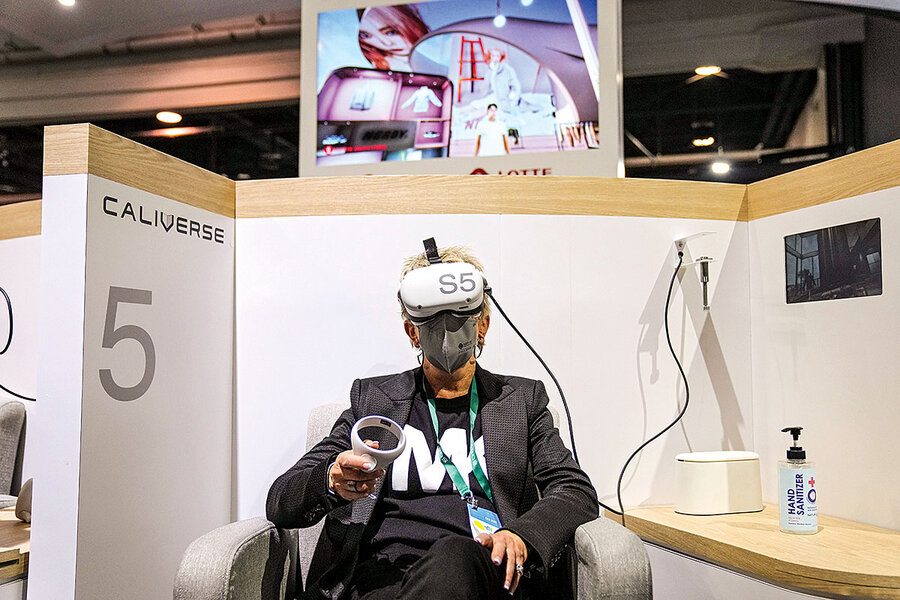The metaverse is coming. But what is it?
Loading...
Are you ready for the “metaverse”?
Tech giants hope so and are investing billions of dollars in the technological long shot. But what actually is it?
Why We Wrote This
Can a virtual realm untethered from the material world bring people together? The “metaverse” is still a technological long shot. But some real-world effects are already being felt.
The metaverse is a kind of virtual realm that allows users from anywhere to interact with each other using virtual reality and augmented reality to mimic the way people connect in the real world. The only thing is the metaverse doesn’t exist yet and probably won’t anytime soon.
Yet the metaverse’s impact on the real world is already tangible. The market for metaverse technologies – from hardware, like headsets, to entire virtual worlds – topped $49 billion in 2020 and is expected to grow by more than 40% each year.
In addition to altering the way we travel and learn, the technology can also help engineers and designers better understand the structure of complex systems through immersive and interactive models.
Metaverse technology also raises concerns – over privacy, autonomy, and equitable access and justice – that need to be further addressed. But for proponents such as Timoni West, one thing is certain: The rise of virtual places “has as much importance as the physical world.”
Imagine putting on a virtual reality headset and attending a meeting, playing virtual chess with friends, or enjoying a concert from the comfort of your living room as a hyperrealistic avatar. Sounds fun and easy, right? Tech giants hope so – and that’s why they are investing billions of dollars in a place called the “metaverse.”
The only thing is the metaverse doesn’t exist yet and probably won’t anytime soon. So why are companies banking on this technological long shot? And why do they think it holds incredible transformative potential?
What is the metaverse, exactly?
Why We Wrote This
Can a virtual realm untethered from the material world bring people together? The “metaverse” is still a technological long shot. But some real-world effects are already being felt.
The metaverse is a kind of virtual interactive realm, but it goes beyond just another social media site that allows users from anywhere to interact with each other. The metaverse uses virtual reality and augmented reality to mimic the way people interact in the real world.
“In the 3D metaverse, we [the participant or player] feel ‘present’ in the space with relative freedom to move about, look around, and even interact with its content and inhabitants,” says Norm Badler, a metaverse researcher at Cesium, a Philadelphia-based 3D geospatial software company. “The latter may be avatars of other live participants, automatically controlled entities [humanlike or otherwise], or pre-created [and stored] animated versions of ourselves,” he adds in an email.
If that concept sounds like a plot from a sci-fi story, that’s because it is. “Metaverse” was coined by Neal Stephenson in his 1992 novel “Snow Crash,” which centered on a 3D virtual world inhabited by user-controlled avatars.
And now the pandemic – which left many people stuck at home yearning for connection to the outside world – has accelerated a shift in thinking about virtual connections. CEO Mark Zuckerberg used the opportunity to rebrand his company, from Facebook to Meta, as a way to prepare for “the next chapter for the internet,” as he described it in an October announcement.
Why should you care about the metaverse?
In short, because you are going to be seeing a lot more immersive technology everywhere. Examples range from Facebook’s Meta transformation to Apple’s coming AR headset to Microsoft Mesh’s virtual collaboration across multiple devices.
Companies are racing to “articulate their vision of a future dependent on immersive media and create immersive worlds and experiences,” says Lisa Messeri, assistant professor of sociocultural anthropology at Yale University, who studies virtual reality.
The market for metaverse technologies topped $49 billion in 2020 and is expected to grow by more than 40% each year, according to Emergen Research’s November 2021 report.
Beyond social media platforms, other research fields have also begun to recognize the benefits of the metaverse. For example, Deborah Richards, professor at the school of computing at Macquarie University in Sydney, Australia, says virtual reality simulations have been effective when treating depression and post-traumatic stress disorder. In some cases, virtual interviewers have outperformed human therapists when trying to help members of the military open up about their mental health.
Yet, metaverse technology also raises concerns – over privacy, autonomy, and equitable access and justice – that need to be further addressed, she says.
What will the metaverse really change?
Metaverse technology has begun to transform the way we travel or learn. More K-12 schools are bringing virtual reality into their curriculum for a more interactive classroom experience. Hyundai envisions Boston Dynamics’ Spot, the quadruped robot, acting as people’s eyes and hands while exploring places they couldn’t reach, like Mars.
The technology can also help engineers and designers better understand the structure of complex systems through immersive and interactive models. Software company Unity recently built a virtual Vancouver International Airport and nearby conservation lands to better understand the environment and potential issues that could arise. Timoni West, vice president of VR and AR at Unity, says advances in the next 50 years will make the digital idea behind the metaverse even more common in everyday uses.
The rise of virtual places and the ability to own real digital content “has as much importance as the physical world,” the Unity executive says.








